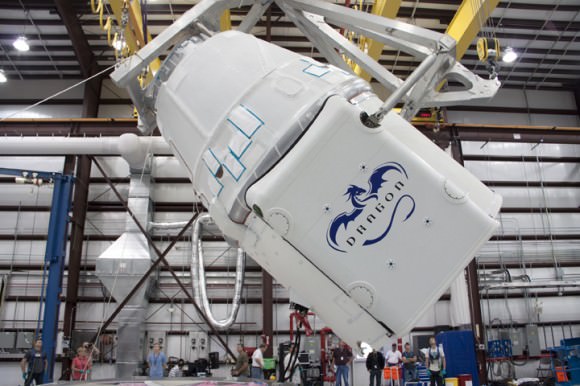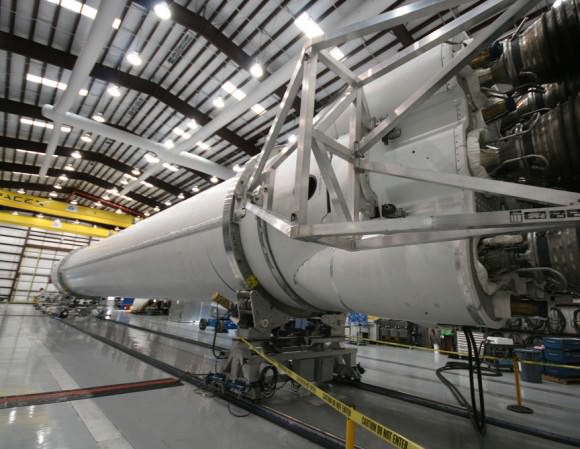[/caption]
On Monday, April 30, SpaceX (Space Exploration Technologies) is all set to conduct a critical static engine test fire of the Falcon 9 rocket at the firm’s launch pad on Cape Canaveral, Florida.
If all goes well, SpaceX and NASA are targeting a May 7 liftoff of the rocket and Dragon spacecraft at 9:38 AM, bound for the International Space Station (ISS). This launch signifies the first time that a commercial company is attempting to dock at the ISS.
The Falcon 9 rocket with the Dragon bolted on top was rolled out to the pad at Space Launch Complex 40 (SLC-40) on the transporter-erecter on Sunday morning (April 29), SpaceX spokesperson Kirstin Grantham told Universe Today.
“The Falcon 9 is vertical. Fueling begins Monday,” said Grantham.
On Sunday night, SpaceX CEO Elon Musk tweeted: “Dragon review completed. All systems now ready for full thrust hold down firing on Monday.”
Today the 180 foot long rocket was moved about 600 feet on rail tracks from the processing hanger to Pad 40 in anticipation of the engine test firing.
During the hotfire test, all nine of the powerful liquid fueled Merlin 1C first stage engines will be ignited at full power for two seconds as part of a full launch dress rehearsel for the flight, dubbed COTS 2. SpaceX engineers will run through all launch procedures on Monday as though this were an actual launch on launch day.
This is the second Falcon 9 launch for NASA as part of the agency’s Commercial Orbital Transportation Services program designed to enable commercial firms to deliver cargo to the ISS following the retirement of NASA’s fleet of Space Shuttles. The first Falcon 9 COTS test flight took place in December 2010.

You can watch a live webcast of the engine test at www.spacex.com starting at 2:30 PM ET/ 11:30 AM PT, with the actual static fire targeted for 3:00 PM ET/ 12:00 PM PT according to SpaceX.
SpaceX is under contract to NASA to conduct twelve resupply missions to the ISS to carry cargo back and forth for a cost of some $1.6 Billion.



6000kg of payload at about $21.000 per kg. (~125million per return trip to the ISS)
I wonder why we still don’t have a space industry out there. oh wait, some elites figured that out as well.
Hello Holland,
SpaceX announced on 29 September last year, that they would attempt to develop powered descent and recovery of both Falcon 9 stages…at which point the long-run cost of flying what would become a fully reusable rocket shrinks to little more that the cost of the fuel.
Nice party trick if they can get it right.
I hear you. Don’t mistake my comment. SpaceX already has a contract worth 1.6bn with an option worth 1.5bn $ for 12 + 12 round trips.
They’re doing great.
But I couldn’t help daydreaming towards a future yet to come.
And to get up there … who you gonna call 🙂
Especially as they are also juggling a lot of other development besides.
“-Hey, I can juggle – schedules!”
That isn’t entirely fair. The Dragon does double-duty and has return capacity.
The hauled mass is ~ 9 000 kg, so (1.6*10^9/12)/9*10^3 ~ 15 000 USD/kg. (I get ~ 135 million/trip, btw.)
– Progress: I can’t get hold of a Progress mission cost, but it lifts ~ 2 400 kg, down 0 kg. You need 4 Progress missions to do the same transport work.
– ATV/HTV: ATV lifts ~ 7 700 kg, down 0 kg. Mission cost ~ 300 MUSD/ATV, ~ 120 MUSD/Ariane 5, so 420*10^6/7.7*10^3 ~ 55 000 USD/kg.
Wikipedia claims cost has come down over time, a man hour on ISS costs ~ 60 % of a man hour on Skylab. I haven’t compared science productivity, but I would bet ISS is more efficient there too.
So space science is getting cheaper, and this is an important part of that. I don’t think the up mass is the main concern though. The Soyuz down mass is some 100’s of kg and no other will provide what this cargo service does: returning experiments and enabling service replacements.
Larsson, this isn’t entirely fair either. My focus was cost vs expectations for in-space industry as proposed by Planetary Resources Inc.
Any secondary Focus truly didn’t come from me. But I agree, it sounds alot. And are much less when you compare them to current transport services.
As for SpaceX, 9000kg is 6000 up, 3000 down. Don’t add those. Down will be less optimaly used, but I agree it does reduce costs and adds a much needed service.
Very well Zoutsteen, but the reader can’t get that from a nebulous hint at considering PRI. One of their putative incomes are from delivering platinum to Earth, so have down mass cargo besides personnel transfers.
I agree that we can’t always add up and down mass, but it is a first clip at total transport cost. Empty cars, trains, boats and planes costs money too, so their economics includes averaging transports.
All fair points, if we look at initial PRI industry they will concentrate on up mass for constructing their water delivery and oxygen/hydrogen production plants and storage facilities. Up mass cost continues to be the key driver for the foreseeable future. It is not the lone cost constraint for the Dragon, so their transport costs will get lower compared to looking at only the key driver.
numbers for your Progress costs: (2007)
3 flights for 5.6 tonnes: 150m USD
Soyuz:
15 seats: 569m USD or 114m USD per Soyuz Launch
Info Grabbed from:
http://forum.nasaspaceflight.com/index.php?PHPSESSID=cacc3b176c1a6466e47df23ab501c996&topic=13441.msg290262#msg290262
Thank you!
Progress costs ~ 27 ooo USD/kg (2007).
you have to remember that this craft will be for human transport which is far more costly than just putting an unmanned payload in orbit. the capsule also has to have return capability which a disposable unmanned rocket does not. this actually will be by far the cheapest rate in the world for manned payloads to orbit.
Soon.
Best of good wishes to SpaceX on their test firing today!
Go Falcon, Go!
I don’t know whether to cheer, or to cry.
I look at the photo and all I see in a (highly) modified V-2 c.1943 (aka. disintegrating totem pole) .
SSTO, SSTO, SSTO.
“What I tell you, three times, is true”. – Robert A. Heinlein.
At least it’s not aimed at London!
to realize reusable rocket, fed upon chemical fuel, hasn’t had the least sense:
1. drastically decreasing payload.
2. more complicated infrastructure.
3. skyscrapped cost to provide service works.
4. accident rate gone wild as well.
——
to hella down the cost would be feasible with magnetic plasma ramjet, powered by MW-class or less nuke reactor.